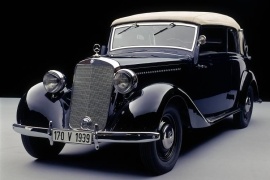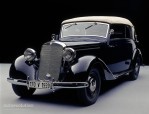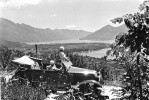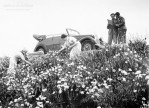Segment: Roadster & Convertible
Production years: 1936, 1937, 1938, 1939, 1940, 1941, 1942
 6 Photos
6 PhotosMercedes-Benz unveiled the 170 V series at the 1936 International Motor and Motorcycle Show in Berlin and offered it in a wide range of bodyworks, including a four-seat convertible named Cabriolet B.
After the Big Depression in the early 30s, the German automaker unveiled a lower-budget lineup: the 170 V, 170 H, and 260 D. The former was the one that caught up the best from them all, especially since it was available in a few open or closed versions, with two or four doors.
In 1933, Mercedes-Benz's design engineer was Dr. Hans Nibel, who worked with the designer Max Wagner. They started to pen the next vehicle with a completely new frame that was 50 kg (110 lbs) lighter than the former Typ 170 (W15) but also stiffer. Its front fascia featured a tilted radiator flanked by headlights, which were mounted on the sides of the engine compartment. The curved front fenders were continued on the sides by the steps that eased the ingress and egress to the vehicle. A pair of rear-hinged doors allowed access to the cabin. The car's canvas top could have been retracted behind the rear seats, above the trunk.
With its cabin fit for four adults, the Typ 170 V Cabriolet B was suitable for young families who needed a stylish vehicle. At the front, the bucket seats were covered in high-quality vinyl. The same material was used for the rear bench and the door cards. On the dashboard, the automaker installed the main dials and gauges in the middle, not in front of the driver.
With its 1.7-liter engine, the Cabriolet B boasted enough performance to attract customers. Moreover, compared to other cars from that era, it was fuel-efficient, a characteristic that helped Mercedes-Benz to sell the Typ 170 in high numbers.
MERCEDES BENZ 170 V Cabriolet B (W136) 1936, 1937, 1938, 1939, 1940, 1941, 1942
- 170 S (50 HP)
- 170 S (60 HP)
MERCEDES BENZ 170 V Cabriolet B (W136)
170 S (50 HP)
ENGINE SPECS - 170 S (50 HP) | |
|---|---|
| Cylinders: | L4 |
| Displacement: | 1912 cm3 |
| Power: | 37 KW @ 3600 RPM 50 HP @ 3600 RPM 50 BHP @ 3600 RPM |
| Fuel System: | Carburetor |
| Fuel: | Gasoline |
PERFORMANCE SPECS | |
|---|---|
| Top Speed: | 68 mph (109 km/h) |
TRANSMISSION SPECS | |
|---|---|
| Drive Type: | Rear Wheel Drive |
| Gearbox: | Manual, 4 Speed |
BRAKES SPECS | |
|---|---|
| Front: | Drums |
| Rear: | Drums |
TIRES SPECS | |
|---|---|
| Tire Size: | 5.25-16 |
DIMENSIONS | |
|---|---|
| Length: | 156.7 in (3980 mm) |
| Width: | 61.8 in (1570 mm) |
| Height: | 61.4 in (1560 mm) |
| Front/rear Track: | 52/51.6 in (1,321/1,311 mm) |
| Wheelbase: | 112 in (2845 mm) |
WEIGHT SPECS | |
|---|---|
| Gross Weight Limit: | 3086 lbs (1400 kg) |
FUEL ECONOMY (NEDC) | |
|---|---|
| Combined: | 21.4 mpg US (11 L/100Km) |
| CO2 Emissions: | 262 g/km |
MERCEDES BENZ 170 V Cabriolet B (W136)
170 S (60 HP)
ENGINE SPECS - 170 S (60 HP) | |
|---|---|
| Cylinders: | L4 |
| Displacement: | 1912 cm3 |
| Power: | 44 KW @ 3600 RPM 60 HP @ 3600 RPM 59 BHP @ 3600 RPM |
| Fuel System: | Carburetor |
| Fuel: | Gasoline |
PERFORMANCE SPECS | |
|---|---|
| Top Speed: | 70 mph (113 km/h) |
TRANSMISSION SPECS | |
|---|---|
| Drive Type: | Rear Wheel Drive |
| Gearbox: | Manual, 4 Speed |
BRAKES SPECS | |
|---|---|
| Front: | Drums |
| Rear: | Drums |
TIRES SPECS | |
|---|---|
| Tire Size: | 5.25-16 |
DIMENSIONS | |
|---|---|
| Length: | 156.7 in (3980 mm) |
| Width: | 61.8 in (1570 mm) |
| Height: | 61.4 in (1560 mm) |
| Front/rear Track: | 52/51.6 in (1,321/1,311 mm) |
| Wheelbase: | 112 in (2845 mm) |
WEIGHT SPECS | |
|---|---|
| Gross Weight Limit: | 3086 lbs (1400 kg) |
FUEL ECONOMY (NEDC) | |
|---|---|
| Combined: | 21.4 mpg US (11 L/100Km) |
| CO2 Emissions: | 262 g/km |





